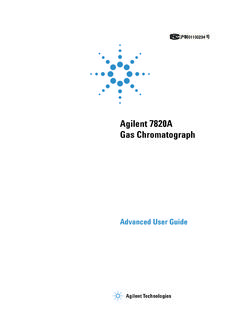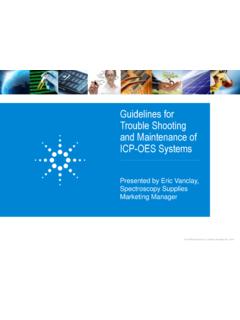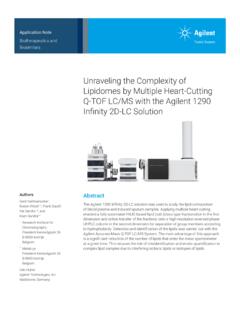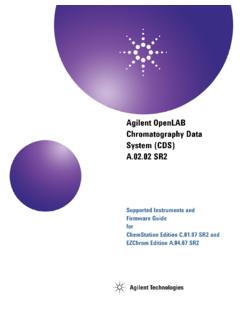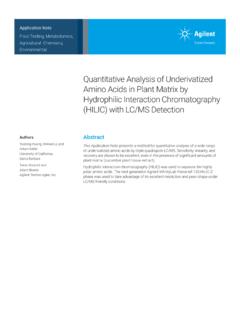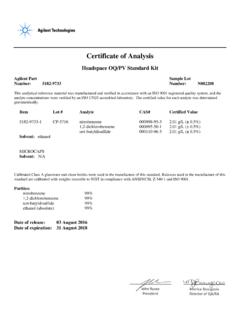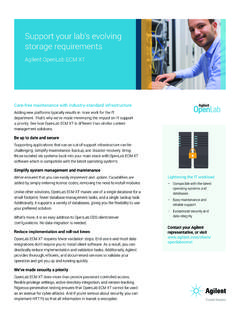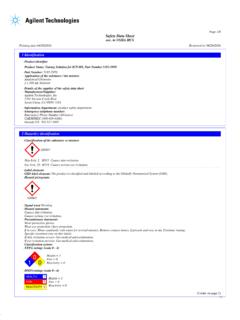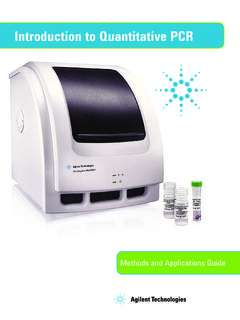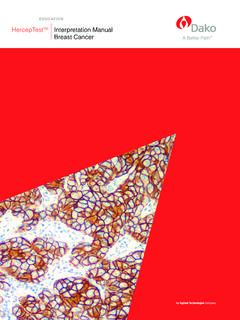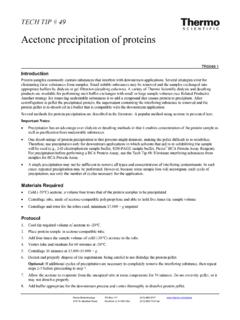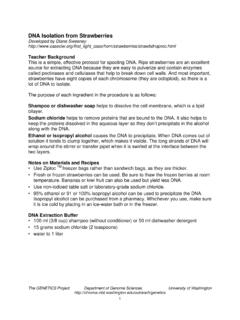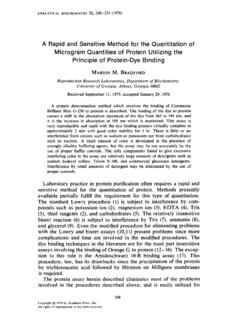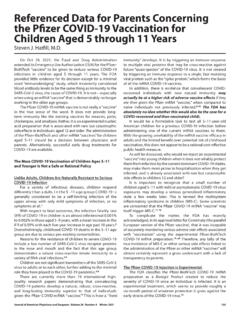Transcription of Protein Precipitation for Biological Fluid Samples Using ...
1 Application NoteClinical ResearchAuthorsLimian Zhao and Megan Juck Agilent Technologies, Precipitation (PPT) is one of the most popular techniques used to prepare Biological Fluid (bio- Fluid ) Samples for LC/MS/MS research analysis. By applying Protein Precipitation to bio- Fluid Samples , proteins can efficiently be removed from the matrix. This Application Note discusses the important steps, considerations, and cautions on PPT for bio- Fluid Samples . It focuses on in-well PPT Using Captiva EMR Lipid 96-well plates, including the appropriate crashing solvent, ratio, additives, bio- Fluid matrix, bio- Fluid sample aliquot and crashing solvent addition order on plate, internal standard (IS) addition, and sample mixing in plate. Lastly, a comparison between traditional PPT Using centrifugation and PPT followed by Captiva EMR Lipid cleanup is discussed in detail, including the time, method performance, and impact on instrument.
2 Protein Precipitation for Biological Fluid Samples Using Agilent Captiva EMR Lipid 96-Well Plates2 IntroductionProtein Precipitation (PPT) has widely been used for bio- Fluid sample preparation for LC/MS/MS research analysis1. Efficient Protein removal is achieved by mixing the bio- Fluid sample with 3 5 times the volume of a water-miscible solvent such as acetonitrile (ACN), methanol (MeOH), or a mixture. The addition of organic solvent destroys the hydration layer of proteins, reduces the repulsive forces between Protein molecules, and significantly lowers the solubility of the proteins, resulting in proteins precipitating out. The precipitates then can be removed by centrifugation or filtration, and the supernatant can be used for research analysis.
3 Even with the potential for some target analyte loss, due to Protein binding or analyte stability affected by Protein binding, PPT methodology still provides fast, simple, cost-effective sample preparation, and is suitable for high-throughput sample analysis. Captiva EMR Lipid 96-well plates allow for in-well PPT, followed by efficient filtration to remove the precipitates. In addition, the EMR Lipid sorbent can interact with lipids in the matrix during sample filtration, resulting in a cleaner eluent, with proteins and lipids being removed simultaneously. This Application Note focuses on discussion of the critical steps for this important sample preparation technique Using Captiva EMR Lipid 96-well solvent and ratioA water-miscible organic solvent is usually used for precipitating proteins, typically ACN, MeOH, or a mixture1.
4 Previous work provides a thorough comparison of PPT Using ACN or MeOH2. Using ACN for PPT usually generates large coagulated yellow precipitates, while MeOH normally generates finer coagulated white precipitates (Figure 1). The clarity of the supernatant is usually a good indication of PPT efficiency, with a hazy supernatant indicating that unprecipitated proteins remain. Figure 1A shows that a minimal crashing ratio of 3:1 when Using MeOH, and 2:1 when Using ACN can provide a clear supernatant. Figure 1B shows that Using ACN with a 3:1 ratio provides a clear supernatant after sample storage at 10 C for 24 hours. These results clearly demonstrate that ACN provides more efficient Protein Precipitation than MeOH, and that a minimal crashing ratio of 3:1 is necessary to achieve efficient Protein removal.
5 However, a larger crashing ratio also results in more sample dilution. Therefore, a crashing ratio of 3:1 5:1 is usually recommended to achieve efficient Protein removal and still maintain reasonable dilution of the sample. Figure 1. Comparison of ACN versus MeOH for PPT. A) Supernatant appearance after mixing and centrifugation; B) supernatant appearance after 24 hours at 10 C. Courtesy of Russ after 24 hours at 10 CAcetonitrile3:12:11:13:12:11:1 MethanolAB3 Another consideration with the crashing solvent is the solvent extraction of target analytes. ACN and MeOH can provide different extraction capabilities on different compounds. A small percentage of MeOH, usually 5 15 %, can be added when there is a need to adjust the solvent extractability of target analytes.
6 However, it is important to understand that even such a small amount of MeOH in the crashing solvent can cause the Protein precipitates to be visually different (Figures 2A and 2B). The more MeOH that is mixed with the crashing solvent, the finer the precipitates can be, which can increase the required pressure when Using filtration to remove precipitates. Since MeOH is not as efficient as ACN for precipitating Protein , excessive amounts of MeOH can negatively impact PPT efficiency. Thus, it is recommended to not exceed 15 % MeOH in the crashing solvent. The third consideration for Using ACN (or primarily ACN) as the crashing solvent is the ease of removal of Protein precipitates by filtration. PPT with ACN results in the Protein Precipitation of larger particulates, making the filtration of precipitates much easier, as they will not clog the filtration frit/membrane.
7 PPT with MeOH results in much finer precipitates, requiring significantly higher pressure for filtration, as fine precipitates tend to clog the filtration frit/membrane easily. To reduce Protein binding, additives such as formic acid (FA) or ammonium hydroxide (NH4OH) are usually spiked into the crashing solvent, with 1 % FA being the most frequently used additive. However, for whole blood PPT, acid addition should be used with caution, as acid can extract more hemoglobin color, resulting in a brown/red supernatant after PPT. Figures 2C and 2D show the supernatant appearance after PPT Using neutral crashing solvent, acidified solvent (with 1 % FA), and basic solvent (with 1 % NH4OH). The supernatant with acidified PPT is dark brown/red in color.
8 Therefore, carefully consider or avoid Using acidified crashing solvent for whole blood PPT. PlasmaABCDW hole bloodPPT by ACNPPT by 95:5 ACN/MeOHPPT by 85:15 ACN/MeOHCrashing solvent with 1 % FACrashing solventCrashing solvent with 1 % NH4 OHCrashing solvent with 1 % FACrashing solventCrashing solvent with 1 % NH4 OHPPT by ACNPPT by 95:5 ACN/MeOHPPT by 85:15 ACN/MeOHFigure 2. Appearance of Protein precipitates formed Using different crashing solvents for plasma (A) and whole blood (B) PPT, and crashing solvent with different additives before precipitates centrifugation (C) and after (D).4 Biological fluids Biological fluids include whole blood, plasma, serum, urine, and other body fluids. Whole blood, plasma, and serum are the major blood matrices with a high abundance of proteins.
9 Thus, it is critical to remove these proteins efficiently before LC/MS/MS analysis. Whole blood is blood that contains an anticoagulant, and is not separated into the liquid portion and blood cells. Serum is the top clear liquid portion separated from blood cells without an anticoagulant, so it does not contain fibrinogen. Plasma is the liquid portion separated from blood cells, and contains the same volume, the abundance of proteins in the matrix follows whole blood > plasma > serum, which is demonstrated by the Protein precipitates generated by PPT (Figure 3). Urine and other body fluids are usually considered as low Protein abundance matrices. PPT is still widely used for these matrices, but efficient Protein removal is not as much of a challenge compared to blood matrices.
10 As a result, there is more flexibility in crashing solvent and crashing ratio used in those bio- Fluid matrices. Often, the PPT used to prepare these sample matrices is called dilute and PPT on Captiva EMR Lipid platePPT can be automated for high-throughput batch processing; thus, the 96-well plate format is being adopted widely. For filtration-based precipitates removal, in-well PPT provides benefits to simplify the workflow. However, preventing clogging caused by precipitates is important for filtration. Agilent Captiva Enhanced Matrix Removal Lipid (EMR Lipid) sorbent provides highly selective and efficient removal of phospholipids and other lipids from Biological fluids after Protein Precipitation . This product is also designed with a depth filtration mechanism, so it provides efficient Protein precipitate filtration without clogging, thus allowing the use of in-well PPT, and simplifying the workflow.
